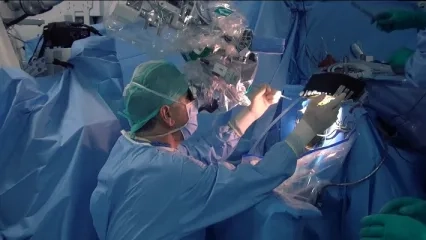Alo Yeditepe
Alo Yeditepe
What is Parkinson's Surgery?
Although Parkinson's is a disease that affects older age groups, it can also be seen in young people. Parkinson's is a neuro-degenerative disease. In other words, it is a disease that results in degeneration, deterioration and cell loss in certain regions of the brain, in the nuclear structure, especially in the main nuclear structure called the basal ganglia. In Parkinson's patients, there is a 50 percent decrease in the main dopamine-secreting cells of our brain. In addition, it also affects many cellular systems. Therefore, although the cause of Parkinson's is still unknown, it is described as a disease that causes cell loss in certain areas of the brain.
Are Environmental Factors Effective in the Occurrence of Parkinson's?
It is known that genetic mutations are important in Parkinson's. However, environmental factors also affect the emergence of the disease. For example, some occupational groups such as those exposed to pesticides, insecticides, heavy metals, metal industry, textile industry, agricultural sector workers are in the risk group for Parkinson's. In addition, vascular occlusion or unregulated substance habits may cause secondary Parkinson's due to damage to the brain. Therefore, it is possible to say that the cause of Parkinson's is multifactorial.
What are the symptoms of Parkinson's?
Although Parkinson's patients may experience symptoms that lead to dementia due to impaired cognitive functions, the most striking symptom is the movement disorder that affects life. Shaking, defined as tremor, is one of the main findings. Although this tremor, which is seen in the arms, hands, head and trunk, can also be experienced at rest, the main problem is that it affects daily life in a way that even prevents eating. Sometimes these tremors can reach a very severe level, defined as "bradykinesia". The patient experiences severe slowness of movement, walks with small steps and loses time even when turning. Since coordination between muscle groups is impaired in Parkinson's patients, the patient often freezes. Body stiffness, defined as rigidity, is experienced and the patient can only move with assistance or is unable to move arms or legs. The fourth main finding is imbalance. The patient generally cannot keep his body structure balanced during movement in the advanced stages. There are some symptoms such as leaning forward. Apart from this, depression is also among the psychiatric findings in Parkinson's patients. Conditions such as swallowing difficulties and drooling from the mouth due to the pharyngeal muscles being affected over time are among the symptoms observed in Parkinson's patients.
How is Parkinson's Diagnosed?
Parkinson's diagnosis can be easily made clinically. A diagnosis of Parkinson's is made if two symptoms specifically mentioned in movement disorder are detected. This is where Neurologists come into play. Neurology and Brain Surgery acts in a multidisciplinary manner during the Parkinson's diagnosis and treatment process.
Can Parkinson's be Treated?
Although it is not possible to completely eliminate Parkinson's, there are medical treatments used in the treatment. Although cognitive functions cannot be reversed, there are powerful weapons used against movement disorders. Effective results can be achieved with drugs that act like dopamine, especially in patients diagnosed with primary Parkinson's. In the case of secondary Parkinson's disease caused by environmental factors, it is not yet as effective.
The second treatment option is surgery. This method, defined as brain stimulation or deep brain stimulation in Parkinson's surgery, is a treatment that turns back time. In the treatment of Parkinson's disease, medication is always used at the beginning of the disease. Over time, when the drug is not effective and symptoms such as dyskinesia that make life difficult occur, deep brain stimulation is applied. Brain stimulation brings this disease back to the period when the drug was effective at the beginning. This is important to know. In other words, after a period of drug treatment due to Parkinson's diagnosis, it is possible to benefit from surgical treatment as a second chance after 5, 10 or 15 years.
How Long Does It Take to Get Results from Parkinson's Pace Surgery?
The recovery process after Parkinson's surgery is essentially "immediate." It can be seen that the flickering decreases dramatically as soon as the battery is turned on.
What Should Be Considered After Parkinson's Surgery?
The cooperation of the patient's relatives is very important after the surgery. Because these patients have to use medication regularly. With surgery, the drug becomes effective again and medical treatment must be used regularly. If necessary, mentoring may be required to support the patient and take him/her around. In addition, regular medical check-ups are also important. Because battery settings are made frequently. In other words, certain areas can be activated on the battery placed in the surgery area. Therefore, close follow-up is very important. The patient, the patient's relative, and the physician act as a family.
This content was prepared by Yeditepe University Hospitals Medical Editorial Board.
”
See Also
- Causes and Treatment Methods of Cervical Herniated Disc
- Brain / Spinal Cord Spine and Nerve Surgery (Neurosurgery)
- Lumbar Spondylolisthesis (Lumbar Slipped Vertebrae)
- Lumbar Spinal Stenosis
- Spinal Fractures
- Narrow Cervical Canal and Myelopathy
- Brain Battery Connecting Parkinson Patients to Life
- Not All Hand Tremors Are Caused by the Parkinson's Disease
- When Does the Spine Require Surgical Treatment?
- Osteoporotic Spinal Fractures Can Cause Bigger Problems If Not Treated Early
- Patient Selection is Important in Parkinson's Surgery
- Canal Narrowing in the Spinal Cord
- Beware If Your Walking Distance Is Decreasing!
Alo Yeditepe


